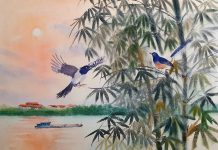Vietnamese Silk Painting and Vietnamese silk art are renowned for their exquisite beauty and deep cultural significance. These art forms have captivated audiences both within Vietnam and around the world, showcasing the country´s rich heritage and artistic prowess. From the delicate brushstrokes to the vibrant colors, Vietnamese silk paintings offer a unique window into the soul of the nation.
Introduction to Vietnamese Silk Painting
Vietnamese Silk Painting is an art form that has been cherished for centuries, reflecting the country´s history, culture, and natural beauty. This introduction will provide a comprehensive overview of what Vietnamese silk painting entails, its historical context, and how it has evolved over time.
Definition and Overview
Vietnamese Silk Painting is a traditional art form where artists use silk as their canvas, painting intricate designs and scenes with natural dyes. The silk´s smooth texture allows for a unique flow of colors and a luminous quality that sets these paintings apart from other mediums. This art form is not just about creating beautiful images; it is a reflection of Vietnam´s cultural identity and heritage.
The essence of Vietnamese silk art lies in its ability to capture the essence of life through delicate brushwork and vibrant hues. Each painting tells a story, whether it´s a serene landscape, a bustling market scene, or a mythological tale. The art form´s versatility allows artists to explore various themes and styles, making each piece a unique expression of the artist´s vision and the country´s cultural narrative.
Historical Context and Evolution
The origins of Vietnamese Silk Painting can be traced back to the Ly Dynasty (1009-1225), where silk was already being used for various purposes, including clothing and decorative arts. However, it was during the Nguyen Dynasty (1802-1945) that silk painting began to flourish as a distinct art form. The royal court´s patronage of the arts provided a fertile ground for artists to experiment and refine their techniques.
Over the centuries, Vietnamese silk art has evolved significantly. Initially, silk paintings were primarily used for religious and ceremonial purposes, often depicting Buddhist themes and deities. As the art form gained popularity, it began to incorporate more secular themes, reflecting everyday life, nature, and folklore. The French colonial period in the late 19th and early 20th centuries also influenced the development of silk painting, introducing new techniques and styles that blended Eastern and Western elements.
Today, Vietnamese Silk Painting continues to thrive, with artists pushing the boundaries of traditional techniques while honoring their cultural roots. The art form´s evolution reflects Vietnam´s dynamic history and its ability to adapt and innovate while preserving its unique identity.
The Materials Used in Vietnamese Silk Art
The creation of Vietnamese Silk Painting relies on a variety of materials, each contributing to the final masterpiece´s beauty and durability. Understanding these materials provides insight into the meticulous process behind each painting.
Types of Silk
Silk is the primary canvas for Vietnamese silk art, and the type of silk used can significantly impact the final result. Traditionally, artists use mulberry silk, known for its fine texture and strength. Mulberry silk is derived from the cocoons of silkworms that feed exclusively on mulberry leaves, resulting in a high-quality fiber that is ideal for painting.
In addition to mulberry silk, some artists may use tussah silk, which comes from wild silkworms. Tussah silk has a coarser texture and a more rustic appearance, often used for paintings that aim to evoke a sense of nature and simplicity. The choice of silk depends on the artist´s intended effect and the theme of the painting, with each type offering unique qualities that enhance the artwork´s overall aesthetic.
Natural Dyes and Their Importance
Natural dyes play a crucial role in Vietnamese silk art, providing the vibrant colors that bring the paintings to life. These dyes are derived from plants, minerals, and other natural sources, ensuring that the colors are not only beautiful but also environmentally friendly. Common natural dyes include indigo for blues, turmeric for yellows, and madder root for reds.
The use of natural dyes is significant for several reasons. Firstly, they allow artists to achieve a wide range of colors that are harmonious and blend well with the silk´s natural sheen. Secondly, natural dyes are more sustainable than synthetic alternatives, aligning with the traditional values of Vietnamese culture. Finally, the process of extracting and applying natural dyes requires skill and patience, adding to the artistry and value of each painting.
Tools and Techniques
The tools used in Vietnamese silk art are simple yet essential for achieving the desired effects. Brushes made from natural fibers, such as bamboo or goat hair, are preferred for their flexibility and ability to hold dye effectively. These brushes allow artists to create fine lines and subtle gradations of color, essential for capturing the nuances of their subjects.
In addition to brushes, artists may use stencils and other tools to create patterns and textures. Stencils are particularly useful for repeating motifs and intricate designs, allowing for precision and consistency across the painting. The technique of layering colors is also common, with artists applying multiple layers of dye to achieve depth and richness in their work.
The combination of high-quality silk, natural dyes, and traditional tools results in Vietnamese silk paintings that are not only visually stunning but also deeply rooted in the country´s cultural heritage.
Traditional Techniques of Vietnamese Silk Painting
The traditional techniques used in Vietnamese Silk Painting are a testament to the skill and creativity of Vietnamese artists. These methods have been passed down through generations, preserving the art form´s unique character and beauty.
Hand-Painting Methods
Hand-painting is the most fundamental technique in Vietnamese silk art. Artists use fine brushes to apply dyes directly onto the silk, allowing them to control every stroke and detail. This method requires a steady hand and a deep understanding of color theory, as the dyes blend and interact with the silk in unique ways.
One of the key aspects of hand-painting is the use of water. Artists often dilute their dyes with water to achieve different shades and transparencies, creating a sense of depth and movement in their paintings. The interaction between the dye and the silk´s surface can produce unexpected effects, adding to the artwork´s spontaneity and charm.
Use of Stencils and Patterns
Stencils are another important technique in Vietnamese silk art, allowing artists to create intricate patterns and designs with precision. Stencils can be made from paper or other materials and are used to apply dyes in specific shapes and motifs. This method is particularly useful for creating repeating patterns, such as floral designs or geometric shapes, that add texture and complexity to the painting.
The use of stencils also allows artists to experiment with different compositions and layouts. By combining hand-painted elements with stenciled patterns, artists can create dynamic and visually engaging works that showcase their creativity and technical skill. This technique is especially popular in paintings that depict traditional Vietnamese motifs, such as dragons, phoenixes, and lotus flowers.
Incorporating Embroidery
Embroidery is a unique aspect of Vietnamese silk art that adds a tactile dimension to the paintings. Some artists choose to enhance their silk paintings with embroidered details, using silk threads to create intricate designs and textures. This technique is often used to highlight specific elements of the painting, such as the petals of a flower or the scales of a dragon.
The combination of painting and embroidery creates a multi-layered artwork that is both visually and physically engaging. The embroidery adds depth and dimension to the painting, making it stand out from traditional two-dimensional artworks. This technique is a testament to the versatility and innovation of Vietnamese artists, who continue to push the boundaries of their craft.
Themes Commonly Found in Vietnamese Silk Paintings
Vietnamese Silk Painting often explores a variety of themes, each reflecting different aspects of Vietnamese culture and life. These themes not only showcase the artists´ skills but also provide a deeper understanding of the country´s heritage and values.
Nature and Landscapes
Nature and landscapes are among the most popular themes in Vietnamese silk art. The country´s diverse geography, from the lush rice terraces of the north to the serene beaches of the south, provides endless inspiration for artists. Silk paintings often depict these natural wonders with vivid colors and delicate brushwork, capturing the beauty and tranquility of the Vietnamese countryside.
One of the reasons nature is such a prevalent theme is its symbolic significance in Vietnamese culture. The lotus flower, for example, is a common motif in silk paintings, symbolizing purity and enlightenment. Similarly, mountains and rivers are often depicted as symbols of strength and continuity. Through their paintings, artists celebrate the harmony between humans and nature, a core value in Vietnamese society.
Daily Life and Cultural Practices
Another common theme in Vietnamese silk art is daily life and cultural practices. These paintings offer a glimpse into the traditions and customs that define Vietnamese culture, from bustling markets and street scenes to traditional festivals and ceremonies. By depicting these everyday moments, artists preserve and celebrate the rich tapestry of Vietnamese life.
One of the fascinating aspects of these paintings is their ability to convey the warmth and vibrancy of Vietnamese communities. Whether it´s a family gathering around a meal or children playing in a village, these scenes evoke a sense of nostalgia and connection. They also serve as a reminder of the importance of community and family in Vietnamese culture, values that are deeply ingrained in the national psyche.
Mythology and Folklore
Mythology and folklore are integral to Vietnamese silk art, providing a rich source of inspiration for artists. These paintings often depict legendary figures and mythical creatures, such as dragons, phoenixes, and fairies, each with its own symbolic meaning. Through these stories, artists explore themes of heroism, morality, and the supernatural, offering insights into the cultural beliefs and values of the Vietnamese people.
One of the most famous myths depicted in silk paintings is the legend of Lac Long Quan and Au Co, the mythical founders of Vietnam. This story symbolizes the union of the mountains and the sea, reflecting the country´s diverse landscapes and the harmony between different elements of nature. By incorporating these myths into their work, artists not only entertain but also educate viewers about Vietnam´s rich cultural heritage.
Regional Variations in Silk Painting Styles
Vietnamese Silk Painting exhibits regional variations that reflect the diverse cultural influences and artistic traditions across the country. These differences add to the richness and diversity of the art form, showcasing the unique perspectives of artists from different regions.
Northern Vietnam Styles
The silk painting style of Northern Vietnam is characterized by its emphasis on subtlety and elegance. Artists from this region often use soft, muted colors and delicate brushwork to create serene landscapes and tranquil scenes. The influence of Chinese art is evident in the use of traditional motifs such as mountains, rivers, and pagodas, which are often depicted with a sense of harmony and balance.
One of the distinctive features of Northern Vietnamese silk paintings is the use of negative space. Artists skillfully leave areas of the silk blank, allowing the natural sheen of the fabric to enhance the overall composition. This technique creates a sense of depth and luminosity, making the paintings appear almost ethereal. The focus on simplicity and refinement reflects the cultural values of the region, where modesty and grace are highly prized.
Central Vietnam Styles
Central Vietnam´s silk painting style is known for its vibrant colors and bold compositions. Influenced by the region´s rich history and cultural diversity, these paintings often depict scenes from daily life, traditional festivals, and historical events. The use of bright hues and dynamic brushstrokes creates a sense of energy and vitality, capturing the spirit of Central Vietnam´s bustling cities and lively communities.
One of the unique aspects of Central Vietnamese silk paintings is the incorporation of folk art elements. Artists often draw inspiration from traditional crafts such as pottery and weaving, integrating these motifs into their work. This fusion of different art forms results in paintings that are both visually striking and culturally significant. The region´s silk paintings are a celebration of its diverse heritage, reflecting the vibrant tapestry of Central Vietnamese culture.
Southern Vietnam Styles
Southern Vietnam´s silk painting style is characterized by its tropical flair and exuberant use of color. Influenced by the region´s lush landscapes and vibrant culture, these paintings often depict scenes of nature, such as rice fields, coconut groves, and waterways. The use of bright, saturated colors and bold brushstrokes captures the warmth and vitality of the Southern Vietnamese environment.
One of the distinctive features of Southern Vietnamese silk paintings is the use of layering techniques. Artists often apply multiple layers of dye to create rich, complex colors and textures, adding depth and dimension to their work. This technique is particularly effective in depicting the region´s lush vegetation and vibrant wildlife, creating a sense of abundance and life. The silk paintings of Southern Vietnam are a testament to the region´s natural beauty and cultural richness, offering a unique perspective on the country´s diverse artistic traditions.
Famous Vietnamese Silk Artists

Vietnamese Silk Painting has been elevated to new heights by the talents of numerous artists who have dedicated their lives to mastering this art form. Their contributions have not only enriched the cultural landscape of Vietnam but also brought international recognition to Vietnamese silk art.
Profiles of Notable Artists
One of the most celebrated Vietnamese silk artists is Nguyen Phan Chanh, whose work is renowned for its delicate beauty and profound emotional depth. Born in 1892, Chanh was a pioneer in the field of silk painting, blending traditional Vietnamese techniques with Western influences. His paintings often depict serene landscapes and tranquil scenes, capturing the essence of Vietnam´s natural beauty.
Another notable artist is Bui Xuan Phai, known for his vibrant and expressive silk paintings. Phai´s work is characterized by its bold use of color and dynamic compositions, reflecting the energy and vitality of Vietnamese life. His paintings often depict scenes from Hanoi´s bustling streets and historic landmarks, offering a unique perspective on the city´s cultural heritage.
Tran Van Can, born in 1910, is another influential figure in the world of Vietnamese silk art. His paintings are known for their intricate details and rich symbolism, often drawing inspiration from Vietnamese mythology and folklore. Can´s work has been widely exhibited both in Vietnam and internationally, earning him a reputation as one of the country´s most talented silk artists.
Contributions to the Art Form
These artists have made significant contributions to the development and recognition of Vietnamese silk art. Nguyen Phan Chanh´s innovative approach to silk painting helped establish it as a respected art form, both within Vietnam and on the global stage. His work inspired a new generation of artists to explore the possibilities of silk as a medium, pushing the boundaries of traditional techniques.
Bui Xuan Phai´s bold and expressive style brought a fresh perspective to silk painting, challenging conventional notions of beauty and aesthetics. His paintings captured the spirit of Vietnamese life, celebrating the country´s rich cultural heritage and vibrant communities. Phai´s work continues to inspire contemporary artists, who seek to emulate his passion and creativity.
Tran Van Can´s focus on mythology and folklore added a new dimension to Vietnamese silk art, enriching its cultural significance. His paintings not only entertained but also educated viewers about Vietnam´s rich history and traditions. Can´s legacy lives on through the many artists who have been influenced by his work, continuing to explore the themes and motifs he so masterfully depicted.
The Role of Silk Painting in Vietnamese Culture
Vietnamese Silk Painting plays a vital role in the country´s cultural landscape, serving as a powerful expression of national identity and heritage. Its significance extends beyond the realm of art, influencing various aspects of Vietnamese life and tradition.
Cultural Identity and Heritage
Silk painting is deeply intertwined with Vietnamese cultural identity, reflecting the country´s history, values, and traditions. The art form´s ability to capture the essence of Vietnamese life, from its natural beauty to its cultural practices, makes it a powerful symbol of national pride. Each painting tells a story, preserving and celebrating the rich tapestry of Vietnamese heritage.
One of the ways silk painting contributes to cultural identity is through its depiction of traditional motifs and symbols. The lotus flower, for example, is a recurring theme in silk paintings, symbolizing purity and enlightenment. Similarly, dragons and phoenixes are often depicted as symbols of power and prosperity. By incorporating these symbols into their work, artists reinforce the cultural values and beliefs that define Vietnamese society.
Silk Painting in Rituals and Festivals
Silk painting also plays a significant role in Vietnamese rituals and festivals, adding a touch of beauty and tradition to these celebrations. During the Tet holiday, for example, silk paintings are often displayed in homes and temples as a way to welcome good fortune and prosperity. These paintings are not only decorative but also carry symbolic meanings, enhancing the spiritual significance of the festival.
In addition to Tet, silk paintings are used in various other rituals and ceremonies, such as weddings and funerals. At weddings, silk paintings depicting scenes of happiness and harmony are often given as gifts, symbolizing the couple´s hopes for a prosperous future. At funerals, silk paintings may be used to honor the deceased, capturing their spirit and legacy in a beautiful and meaningful way.
The integration of silk painting into these rituals and festivals underscores its importance in Vietnamese culture. It serves as a bridge between the past and the present, connecting generations and preserving the country´s rich cultural heritage.
The Global Influence of Vietnamese Silk Art
Vietnamese Silk Painting has gained international recognition, captivating audiences around the world with its beauty and cultural significance. Its global influence extends beyond the art world, impacting various aspects of culture and society.
Exportation and International Recognition
The exportation of Vietnamese silk art has played a crucial role in its global recognition. As silk paintings began to be showcased in international exhibitions and galleries, they attracted the attention of art enthusiasts and collectors worldwide. The unique beauty and cultural depth of these paintings set them apart from other art forms, earning them a place in prestigious collections and museums.
One of the key factors contributing to the international success of Vietnamese silk art is its ability to transcend cultural boundaries. The themes and motifs depicted in these paintings, such as nature, daily life, and mythology, resonate with audiences from diverse backgrounds. This universal appeal has helped to establish Vietnamese silk painting as a respected and sought-after art form on the global stage.
Fusion with Other Art Forms
The global influence of Vietnamese silk art is also evident in its fusion with other art forms. Many contemporary artists have experimented with combining silk painting with techniques from Western art, such as oil painting and mixed media. This blending of styles has resulted in innovative and visually striking works that showcase the versatility and adaptability of silk as a medium.
In addition to visual art, Vietnamese silk art has influenced other creative fields, such as fashion and interior design. Designers have incorporated silk paintings into their collections, using them to add a touch of elegance and cultural richness to their creations. This cross-pollination of art forms highlights the enduring appeal and relevance of Vietnamese silk painting in the modern world.
Modern Trends in Vietnamese Silk Painting
As Vietnamese Silk Painting continues to evolve, it embraces new trends and techniques that reflect the changing times. These modern developments not only enhance the art form´s beauty but also ensure its continued relevance and vitality.
Contemporary Artists and New Techniques
Contemporary Vietnamese silk artists are pushing the boundaries of traditional techniques, experimenting with new methods and styles. One of the emerging trends is the use of digital technology in silk painting, allowing artists to create intricate designs and patterns with greater precision. This fusion of traditional and modern techniques results in innovative and visually stunning works that appeal to a new generation of art enthusiasts.
Another trend is the exploration of abstract and conceptual themes in silk painting. While traditional silk paintings often depict realistic scenes and motifs, contemporary artists are increasingly using silk as a medium for abstract expression. These paintings challenge conventional notions of beauty and aesthetics, inviting viewers to engage with the art on a deeper level.
The Impact of Technology on Silk Painting
Technology has had a significant impact on Vietnamese silk art, revolutionizing the way artists create and share their work. Digital tools and software allow artists to experiment with different compositions and color palettes before committing to the silk canvas. This ability to preview and refine their work enhances the creative process, resulting in more polished and sophisticated paintings.
In addition to aiding the creative process, technology has also facilitated the global dissemination of Vietnamese silk art. Online platforms and social media have enabled artists to reach a wider audience, showcasing their work to art enthusiasts around the world. This increased visibility has not only boosted the international recognition of Vietnamese silk painting but also fostered a sense of community among artists and collectors.
Preserving the Tradition of Silk Painting
Preserving the tradition of Vietnamese Silk Painting is essential for maintaining the country´s cultural heritage and ensuring the art form´s continued vitality. Various efforts are being made to educate and train new generations of artists, as well as to support the work of cultural institutions.
Education and Training Programs
Education and training programs play a crucial role in preserving the tradition of Vietnamese silk art. Many schools and art institutions offer courses in silk painting, teaching students the techniques and skills needed to create beautiful and meaningful works. These programs not only pass on the knowledge and expertise of experienced artists but also encourage innovation and creativity.
One of the challenges in preserving silk painting is the need to balance tradition with modernity. While it is important to honor the art form´s historical roots, it is equally important to allow for experimentation and evolution. By providing students with a solid foundation in traditional techniques, as well as opportunities to explore new ideas and approaches, these programs ensure the continued growth and relevance of Vietnamese silk art.
Efforts by Cultural Institutions
Cultural institutions, such as museums and galleries, also play a vital role in preserving and promoting Vietnamese silk art. These institutions organize exhibitions and events that showcase the work of both established and emerging artists, raising awareness and appreciation for the art form. By providing a platform for artists to share their work, these institutions help to foster a vibrant and supportive community.
In addition to exhibitions, cultural institutions often engage in research and documentation efforts, preserving the history and techniques of Vietnamese silk art for future generations. This work is essential for ensuring that the art form´s rich cultural heritage is not lost to time. By collaborating with artists, educators, and other stakeholders, these institutions contribute to the ongoing preservation and development of Vietnamese silk art.
Collecting and Appreciating Vietnamese Silk Art
Collecting and appreciating Vietnamese Silk Painting is a rewarding experience that offers a deeper understanding of the country´s cultural heritage. Whether you are a seasoned collector or a novice enthusiast, there are various tips and guidelines to help you navigate the world of Vietnamese silk art.
Tips for Collectors
For those interested in collecting Vietnamese silk art, it is important to start by researching the artists and their work. Familiarize yourself with the different styles and techniques, as well as the historical and cultural context of the paintings. This knowledge will help you make informed decisions and appreciate the nuances of each piece.
When purchasing silk paintings, consider the authenticity and provenance of the work. Look for pieces that come with documentation or certification from reputable sources, ensuring that you are investing in genuine Vietnamese silk art. Additionally, consider the condition of the painting, as silk is a delicate material that requires careful handling and storage.
How to Care for Silk Paintings
Caring for Vietnamese silk art is essential for preserving its beauty and longevity. Silk paintings should be stored in a cool, dry place, away from direct sunlight and humidity. Avoid hanging them in areas with high traffic or where they may be exposed to dust and pollutants.
When cleaning silk paintings, use a soft, dry cloth to gently remove any dust or debris. Avoid using water or cleaning solutions, as these can damage the silk and the dyes. If the painting requires more thorough cleaning, consult a professional conservator who specializes in textile art.
By following these tips and guidelines, collectors can enjoy and appreciate Vietnamese silk art for years to come, preserving its beauty and cultural significance.
Conclusion
Vietnamese Silk Painting is a testament to the country´s rich cultural heritage and artistic prowess. From its historical roots to its modern innovations, this art form continues to captivate audiences with its beauty and depth. By exploring the materials, techniques, themes, and regional variations of Vietnamese silk art, we gain a deeper appreciation for its significance and enduring appeal. As we look to the future, the preservation and promotion of this art form will ensure that its legacy continues to inspire and enrich the world of art and culture.


























